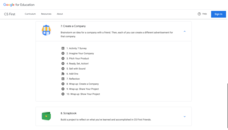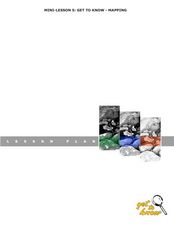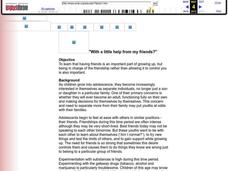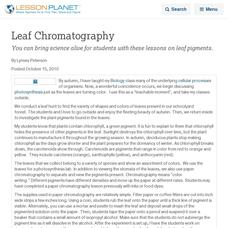Agriculture in the Classroom
A Rafter of Turkeys
How did that turkey get from the early Aztec culture to your table? Learn about the history of wild and domesticated turkeys in North America, as well as their inclusion in Thanksgiving traditions, with a two-part agricultural science...
K12 Reader
Identifying Adverbs IV
What a mess! Read about Lilly-Ann's birthday cupcake surprise and work on grammar skills at the same time. Four lengthy paragraphs provide kids with many opportunities to find and circle adverbs. They note the ways that adverbs come in...
It's About Time
Effects of Plate Tectonics
Explore our world from within as you lead young scientists on a thrilling adventure. Pupils examine the location of plate boundaries to determine earthquake and volcano distribution around the globe and explore the cause of hot spots in...
Google
Friends: Create a Company
Create a company, advertise it, and hope it grows. The seventh of eight parts in the Google CS First Friends unit challenges future business leaders to apply computer coding to create an advertisement for a company. After pairs come up...
Science-Class.net
Rock Candy Crystals
Candy is one of my favorite words, and it's an even better word when it relates to science. Yes, candy science can happen when you grow rock candy crystals with your class. The entire process for growing these edible wonders of nature is...
Carnegie Mellon University
Bathtub Model
Using a colorful infographic handout and a guide sheet, hold a class discussion about how a bathtub can serve as a model for the greenhouse effect created by Earth's atmosphere. Participants will understand that as energy or matter is...
Curated OER
Your Future Occupation
What do your middle schoolers want to be when they grow up? Have them write about possible occupations in this writing lesson. After brainstorming the different occupations they would like, they write a story about what they will do on...
Curated OER
Bringing Up Birdy
Students explore biology by creating diagrams of animal life cycles. In this baby bird lesson, students view video clips of birds being born from incubation to flying on their own. Students utilize the Internet to research birds and...
Curated OER
Mini - Lesson #5: Get To Know - Mapping
Students examine and draw landscape maps. In this mapping lesson, students investigate what a landscape map is. They draw a map showing objects on a small piece of natural landscape. Students fill in a grid sheet and a worksheet to make...
Curated OER
Honey Bees and Communication
Did you know that honey bees dance to communicate information? Do you know why bees use hexagons to build their hives? The Honeybee Man, Brilliant Bees, and Show me the Honey provide background information on how honey bees communicate....
Curated OER
The Peanut Wizard
Students read and discuss information regarding George Washington Carver and how the peanut became cultivated in the southern colonies of the United States. In this George Washington Carver instructional activity, students develop...
National Endowment for the Humanities
The House Un-American Activities Committee
Was the House Un-American Activities Committee justified in investigating subversive influences in the entertainment industry? Part two of the three-part series of lessons that examine the anti-communism movement after World War II,...
California Academy of Science
Kinesthetic Astronomy: Moon Phases
We are the world! Each of your class members models Earth and holds a styrofoam ball to see its phases. Thorough teacher background information and a detailed lesson plan will make this a cinch to teach. If you do not want to purchase...
National Wildlife Federation
Quantifying Land Changes Over Time in Areas of Deforestation and Urbanization
Is qualitative or quantitative research more convincing when it comes to climate change? In the eighth lesson during this 21-part series, scholars begin by performing a quantitative analysis of deforestation and urbanization. Then, they...
Curated OER
With a little help from my friends
Students examine how having friends is an important part of growing up, but being in charge of the friendship rather than allowing it to control you is also important.
Curated OER
Leaf Chromatography
You can bring science alive for students with these lessons on leaf pigments.
Curated OER
Where Do They Grow?
Students complete worksheets. In this fruits and vegetables instructional activity, students complete a worksheet on where fruits and vegetables grow where they draw connecting lines. Students color fruits and vegetables on a worksheet.
Curated OER
Earth Day - Grow A Seed Garden
Students discover how things grow and how they can take better care of the environment in this Earth Day lesson for the elementary classroom. The activity can be accomplished in one day and left in the sun until the "beans" begin growing.
Curated OER
Flowers Growing Through Music, Rhymes & Movement
First graders experience the growing process of a seed becoming a flower as it is exposed to the sun, rain, wind, day and night, and -tickling- bees as they move creatively to music.
Curated OER
Hold on Tight!
Students explore the relationship between plant roots and the soil in which they grow. They examine photos of uprooted trees and desert areas and
conduct experiments designed to highlight this mutual relationship between roots and soil....
Curated OER
Ocean Exploration: How Doea you Data Grow? (Grades 7-8)
Learners explore fieldwork. In this seventh or eighth grade mathematics lesson plan, students watch a video on data collection in the field. Learners use fieldwork to gather data about their school environment. Students compile data...
Curated OER
10 Apples Up On Top
Stuents make class books as a follow up activity to the Dr. Seuss book Ten Apples Up On Top!
Curated OER
Growing as a Group
Students design a plan to help families who are in need. In this citizenship instructional activity, students brainstorm and implement a service project in their own community. Students discuss how to provide food for families who are in...
Curated OER
We're All The Same on the Inside
Learners discuss prejudice around the Martin Luther King, Jr. holiday. They use brown and white eggs to discover that they are both the same on the inside even though they look different on the outside.

























